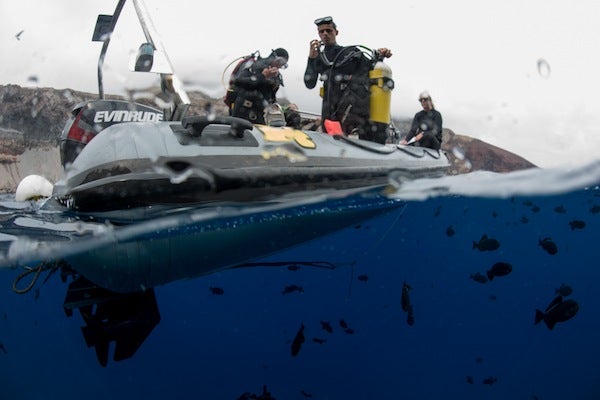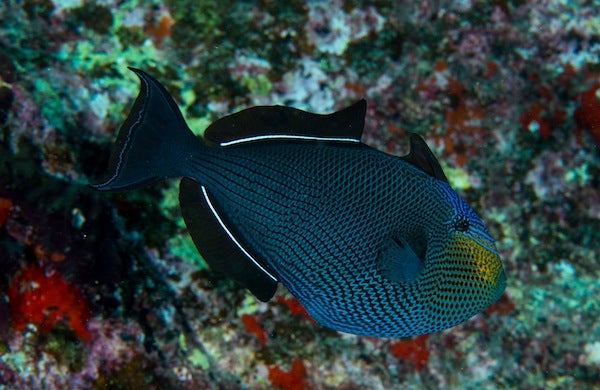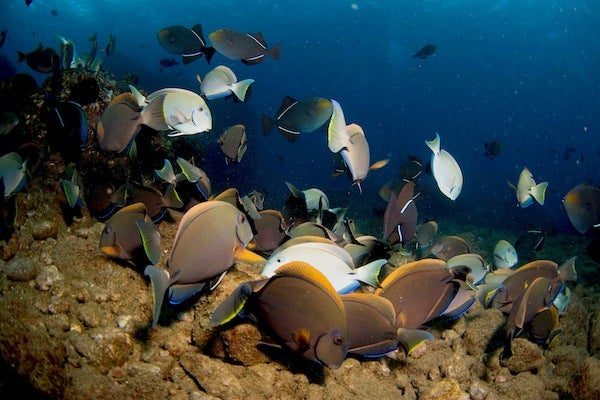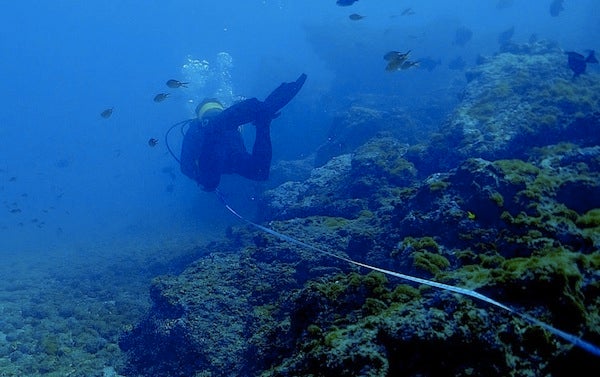This article was published in Scientific American’s former blog network and reflects the views of the author, not necessarily those of Scientific American
Editor's note: There’s a fascinating natural experiment happening around Ascension Island. While the number of fish here is astounding, surprisingly few species have been hardy enough and lucky enough to make the long journey and settle here successfully. Now a team of scientific divers has taken the rare and brief opportunity to come to this rock in the middle of the Atlantic Ocean and study one of the most poorly understood marine communities in the world—to try to figure out where these fish come from, how long they’ve been here, and how they’re making a living in such isolation.
With his half-filled collection bag in tow, Luiz Rocha is high-tailing it out of the water. Although there’s more sampling to be done and he still has plenty of air left in his tank, the scientist, a curator of ichthyology at the California Academy of Sciences, can’t afford to lose any more specimens. It’s not sharks that Rocha’s worried about. The Galápagos sharks that have followed our blood trail on earlier collecting dives are nowhere to be seen. This threat, though, is unrelenting, and the pursuers outnumber us by a wide margin. After 45 minutes underwater, Rocha has had enough.
“Sons o’ bitches,” he says with equal parts admiration and frustration as he fights his way through the surf and onto the narrow beach fringing this corner of Ascension Island's Comfortless Cove. In his wake, a school of 30 or more black triggerfish (Melichthys niger) mill around like a group of nervous, but hopeful, dogs at a barbecue as the last few snacks are packed away. Fifteen minutes later, they haven’t given up. Even though the rest of the dive team carries nothing more than cameras and measuring tapes, the fish trail them, too, as they make their way back toward the beach.
On supporting science journalism
If you're enjoying this article, consider supporting our award-winning journalism by subscribing. By purchasing a subscription you are helping to ensure the future of impactful stories about the discoveries and ideas shaping our world today.
In the following video, a specimen intended for Rocha’s collection bag quickly becomes the focus of a massive feeding mob of black triggerfish (video by Steven Bedard):
Black triggerfish, or simply “blackfish” as the Ascension locals call them, are found in nearly every imaginable tropical reef habitat around the world. In most places, their numbers tend to be relatively modest. Here, and around a few other isolated oceanic islands, they literally swarm. Although the scientists aren’t entirely sure why the species has been so successful around these rocky outcrops, they think it’s probably a combination of the relatively low numbers of predators and competitors here, as well as the fish’s uncanny blend of omnivory and opportunism when it comes to food choice. You can’t possibly go in or even near the waters of Ascension without seeing black triggerfish cruising the shallows in large, loosely organized groups waiting for a meal, any meal, to drift, swim or drop into their paths. And it’s just as common to see them grazing along the algae-covered bottom like herds of hungry goats.

Black triggerfish await the research team as they prepare for a dive at Ascension's Boatswain Bird Island. (Photo by Luiz Rocha)
Having read about and seen dozens of pictures of blackfish before I came to Ascension, I didn’t expect to like or appreciate them as much as I do. Photos of their dense, dark schools made them look more like pests than attractions, but they’re really quite beautiful and fascinating. Despite the name, they’re not actually black. While they often appear dark as pitch in low light, better illumination reveals a deep indigo interwoven with a complex pattern of olive green, light blue and gold as ornate as any Persian rug.
Sky-blue pinstripes delineate the fish’s ribbon-like fins, which propel them through the water with rhythmic flutters—a motion that brings to mind the flight pattern of a butterfly more than the aggressive tail swipes of a predator. Often the fish seem downright passive. On any given dive, it’s common to see individuals laying on their sides, molding their 12-inch-long, oval-shaped bodies into shallow depressions in the volcanic rock, an apparent effort to blend into the background until the danger has passed.

The black triggerfish’s name belies its brilliantly ornate coloration. (Photo by Luiz Rocha)
That timidity goes out the window when an energy-rich food source comes into view. Not only do the triggerfish brazenly snatch bites of flesh through the holes in Rocha’s mesh collection bag, they compete hard for nearly every potential specimen that ends up at the tip of his spear. Most of the time, he wins the battle, but not always. Regardless, whenever there’s an opportunity for a meal, a seemingly aimless school of triggerfish quickly becomes an unruly mob.
Mob feeding is actually the technical term biologists use to describe this sort of behavior—this overwhelming display of numbers and force. Naturally, the tactic is not restricted to harassing scientific divers, or to dispensing with the unwanted bits of flesh thrown back into the sea by local fishermen—as they do each afternoon at the pier in the heart of Georgetown, Ascension’s main settlement. These are the human-influenced, and probably exaggerated, versions of what is a fairly common feeding strategy among a number of reef fish species. In fact, most of the mob feeding we’ve observed in the waters here is herbivorous in nature.
As the marauding group of sergeant majors in the following video proves, triggerfish aren't the only Ascension residents that use mob-feeding to overwhelm other species guarding a territory (video by Steven Bedard):
There are probably a couple of advantages to this sort of frenzied approach to feeding, even for herbivores. First, traveling in large numbers affords the members of a shoal of fish some level of protection from predators. But more relevant to feeding—and grazing in particular—a group of fish moving quickly and aggressively in large numbers stands a much better chance of overwhelming territorial species standing guard over a patch of habitat. In Ascension, the primary turf defenders that seem to make mob feeding a necessity are the diminutive damselfish (Stegastes lubbocki) and brown chromis (Chromis multilineata). Although they’re each around two inches long—just over one-tenth the size of a blackfish—these fish are no pushovers and spend the better part of each day driving off would-be grazers.

A mixed mob of ocean surgeonfish, blue tangs, and triggerfish graze along the algae-covered bottom. (Photo by Judith Brown)
Black triggerfish aren’t the only species that use mob feeding to steal back some of those grazing rights. We’ve seen mixed schools of ocean surgeonfish and blue tangs feeding in this way, their coffee-colored and royal-blue disk-shaped bodies vigorously stirring up clouds of detached algae bits and sediment. Another species, the sergeant major (Abudefduf saxatilis), has gotten in on the act as well, and has gone a step farther—mimicking not only the triggerfish’s mob-feeding behavior but also its dark coloration. It’s a strange phenomenon that this seasoned group of reef-fish biologists has never seen before and one that’s yet to be documented in the scientific literature.
Together, all these feeding mobs exert a powerful ecological pressure on Ascension’s rocky reefs. The shear number of fish—a tremendous amount of biomass—combined with the ravenous appetites required to sustain all those bodies, amounts to a lot of food being consumed. Figuring out just how much food these reef herbivores eat is one of the many objectives of this expedition. It’s why Sergio Floeter, Carlos Ferreira and Renato Morais, all members of the Brazilian Marine Biodiversity Network, spend nearly every minute they have underwater either placing Go-Pro cameras in strategic locations along the ocean floor or conducting fish surveys along 20-meter transects laid out at varying depths across Ascension’s rocky reef habitats.

Renato Morais conducts a biodiversity survey along a 20-meter transect, recording species, number, and size of fish as he goes. (Photo by Steven Bedard)
Once the expedition is complete, the team will use the survey data to estimate just how much fish biomass there is in a given area around Ascension Island. They’ll also spend weeks examining hours of underwater video footage, literally counting the number of bites of algae that fish herbivores take in a given area during a particular period of time. This research, funded by the Brazilian National Council for Scientific and Technological Development (Brazil’s equivalent of the NSF) will allow the scientists to better understand the critical roles that these fish species play in the ecology of Ascension. And by comparing what they’ve seen here to what they’ve observed in other ecological communities along the coasts of Brazil and around other islands in the Atlantic, the scientists will be able to predict what impact a change in the biodiversity and abundance of these fish might have on the entire system.
But for now, with two more dives completed and the day’s samples—both tissues and stomach contents from a number of different species—neatly catalogued in tiny vials of ethanol, there’s another task at hand. The five of us pile out of our borrowed Land Rover and once again make our way down the crumbling concrete walkway to the waters edge at “Guano Jetty.”
“Feeding frenzy!” Rocha announces as we reach the end of the path. Whether he’s speaking to us or the intended beneficiaries of this banquet, it’s not clear.
He crouches, opens the small bag at his feet, and with a bare hand, scoops up a wet mass of fish intestines and fat and flings the wad into the water. The triggerfish respond immediately, churning the water in a dark, desperate mass of bodies, fins and hungry mouths. More numerous, more aggressive and seemingly more willing to stretch our concept of dietary norms, the fish once again put on an awe-inspiring display of opportunism—a display that these fish biologists never seem to grow tired of watching.
More installments in this series:
"The Unusual Abundance of Ascension Island" (August 31, 2015)